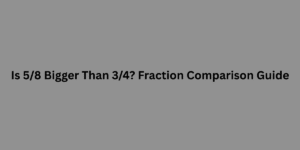Fractions can be tricky—especially when comparing two that don’t share the same denominator. A common question that often arises in math classes, standardized tests, and everyday situations is: Is 5/8 bigger than 3/4? The answer might not be immediately obvious, but with the right strategies, it’s easy to figure out.
To find out which fraction is smaller, we make the bottom numbers (denominators) the same. After doing that, it’s easy to compare the top numbers. When we do this with 3/4 and 5/8, we see that 3/4 is actually bigger than 5/8 — not smaller.
In this comprehensive guide, we’ll break down how to compare 5/8 and 3/4 using multiple methods, including visual aids, decimal conversion, and finding common denominators. By the end, you’ll not only know which fraction is bigger but also understand how to tackle similar fraction comparison problems with confidence.
Understanding the Basics of Fractions

Before diving into comparisons, let’s clarify what fractions represent:
- Numerator: The top number that shows how many parts you have.
- Denominator: The bottom number that tells you how many parts make up a whole.
So, 5/8 means you have 5 out of 8 parts, and 3/4 means 3 out of 4 parts. But since the denominators differ, you can’t compare them directly without additional steps.
Method 1: Converting to Common Denominators
One of the most reliable ways to compare fractions is by finding a common denominator.
Step-by-Step:
- Find the Least Common Denominator (LCD) of 8 and 4. The LCD is 8.
- Convert each fraction to have that denominator:
- 5/8 remains 5/8.
- 3/4 becomes 6/8 (because 3 x 2 = 6 and 4 x 2 = 8).
Compare the numerators: 5/8 vs. 6/8 → 6/8 is greater.
- Conclusion: 3/4 is bigger than 5/8.
Method 2: Converting to Decimals
This method is quick and easy, especially with a calculator or spreadsheet.
How to Do It:
- 5 ÷ 8 = 0.625
- 3 ÷ 4 = 0.75
Conclusion: 0.75 is greater than 0.625, so 3/4 is bigger than 5/8.
Method 3: Using Visual Aids
Visual models can help students and visual learners grasp the concept quickly.
Pie Charts or Bars
- A circle divided into 8 parts: shade 5.
- Another circle divided into 4 parts: shade 3.
- Visually, the shaded area of 3/4 is larger.
Tip: Consider using infographics or fraction bars in educational materials to support comprehension.
Real-World Examples
Cooking
You need 3/4 cup of sugar but only have a 1/8 measuring cup:
- You’d need six 1/8 scoops (6/8) to equal 3/4.
- If you only use five 1/8 scoops (5/8), you’re short.
Construction
Cutting a wooden plank:
- One piece is 5/8 of the original length.
- Another piece is 3/4.
- Which is longer? The one that is 3/4, as confirmed by both conversion methods.
Additional Tips for Comparing Fractions
Cross Multiplication: Multiply the numerator of one fraction by the denominator of the other and vice versa.
- 5 x 4 = 20
- 3 x 8 = 24
- 24 > 20, so 3/4 > 5/8
- Fraction Strips: Use paper strips or online tools to see comparative lengths.
Benchmark Fractions: Know that 1/2 = 0.5, 3/4 = 0.75, etc., to help estimate values.
Common Mistakes to Avoid
- Ignoring Denominators: Comparing numerators directly (5 vs. 3) is misleading when denominators are different.
- Incorrect Conversions: Always double-check decimal or fraction conversions.
- Overlooking Simplification: Simplified fractions are easier to compare.
Why This Matters in Education
Fraction comparison skills are fundamental in:
- Primary and middle school math
- Standardized testing (SAT, ACT, GRE)
- Real-life decision-making (e.g., budgeting, cooking)
Mastering this skill early helps build number sense and confidence in math.
Conclusion
So, is 5/8 bigger than 3/4? The answer is no—3/4 is bigger than 5/8. Whether you compare them by converting to a common denominator, decimals, or using visuals, the result is the same.
Understanding how to compare fractions is not only essential for academics but also useful in daily life. By mastering these techniques, you’ll be better equipped to tackle a wide range of mathematical problems with ease.

